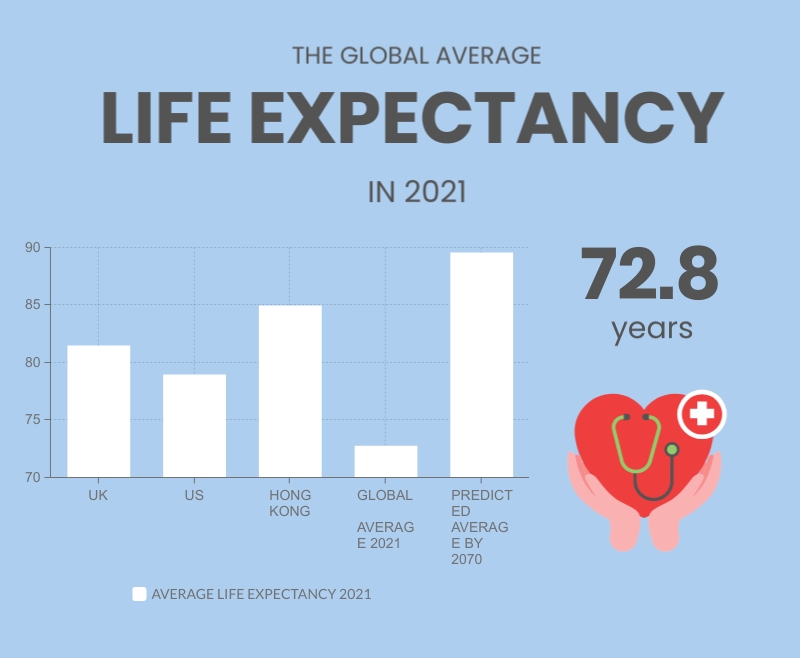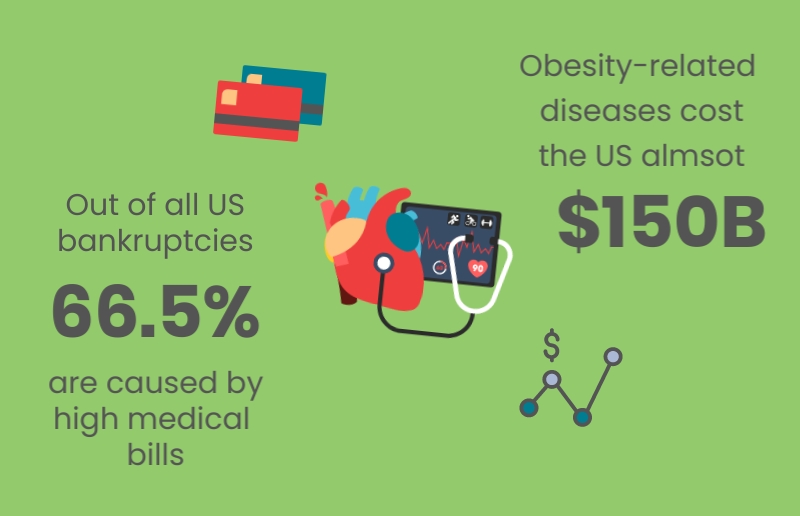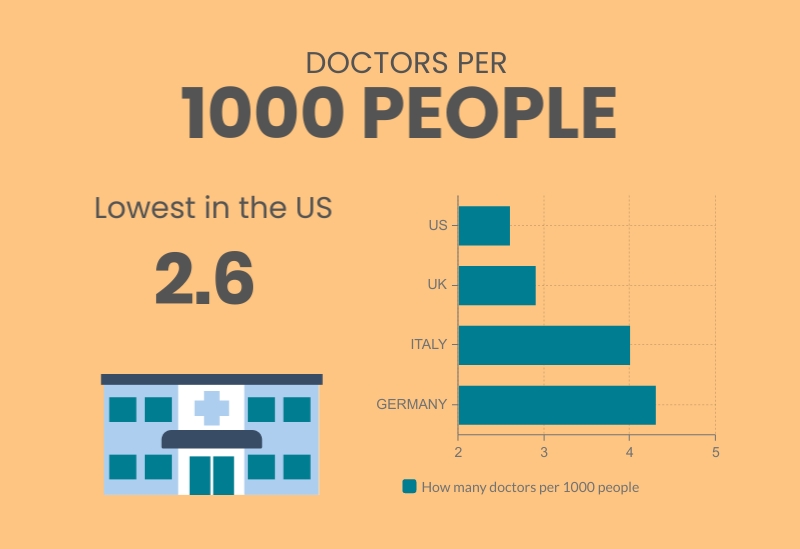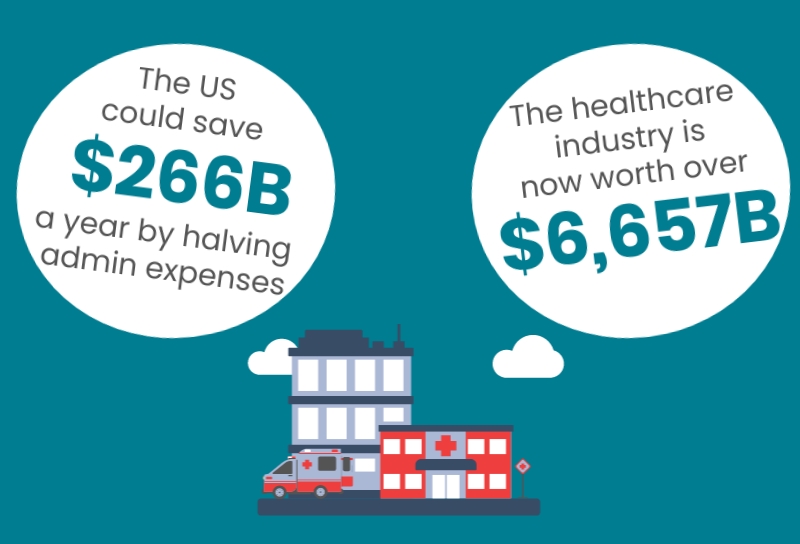Technology has come a long way since the first iPhone was released in 2007; these medical...
The Top Ten Medical Statistics of 2022 That Will Shock You
Every year, there are new medical breakthroughs that change the face of healthcare. With all the information available such as data, graphs, and medical statistics, it’s hard to know what’s reliable and what’s relevant. So, where do you start?
Doctors receive a lot of information every day. From patient care to research papers – there is always something new to learn. In terms of statistics in medicine, the future has never looked more promising for doctors.
Over the coming years, we will see an increase in medical innovations with a decrease of time spent on paperwork; medical technology development is off the charts and by the end of 2022, over half of all doctor’s appointments could be conducted remotely.
With these changes, it’s important that doctors stay up to date so that they can provide better care for patients. To help you understand the trends and know what to expect in the coming years, we’ve explored the 10 most shocking medical statistics of 2022.
Why do doctors use medical statistics?
Doctors are often the first to know when a new medical study is published. They read journals, attend conferences and weigh in on studies themselves. But, after years of rigorous training and exams, why should doctors need stats?
Medical statistics are the backbone of research. They help doctors and patients make informed decisions about their healthcare. Statistics and data can be a complicated subject for many people – it can seem like an endless maze of numbers, percentages, and charts. But when you really break down what these things mean, it’s not so confusing after all.
Doctors use statistics in medicine to measure risks, evaluate evidence and interpret results of elaborate testing. They may be reliant on medical stats to inform a lot of their decisions. However, a recent study found that doctors often fail to accurately assess the risks of treatment, and instead rely too heavily on statistical data.
Here’s an example
A doctor might have a patient who is considering surgery for appendicitis. The doctor knows that between 85% and 94% of patients who undergo this type of procedure experience no complications or pain after the operation. So, when asked about whether they should go ahead with the surgery, most doctors will say yes because it’s statistically sound.
The problem is that there are always exceptions – up to 15% of patients experience some complications following appendectomy surgery. So, while the odds are in favor of going ahead with the operation, you can never be too careful.
Especially when it comes to medical statistics of fairly new concepts or developments (such as robotic surgery or the coronavirus vaccination). Admittedly, they’re very well thought out, but they’re new nonetheless which makes people, and doctors, more cautious.
Nevertheless, the future of medicine is morphing before our very eyes and these medical stats go a long way to support this.
What are the top statistics in medicine in 2022
The world of medicine is changing before our eyes. Things that used to be fatal are a thing of the past and things that were once recreational activities could now prove fatal. These are the most interesting medical statistics of 2022 and some of them will definitely shock you.
1. Patients in the US pay 2.6% more for drugs than in other countries
Rand’s study compared the price of prescription drugs in the US to 32 comparison countries including Mexico and Turkey. The US came out considerably higher on all accounts. On average, patients in the US pay 2.56% more for drugs with the gap even higher for branded drugs, with US prices averaging 3.44% more.
When you consider that 70% of Americans take at least one prescription drug and one-fifth of Americans are taking five or more, this is a shocking statistic.
Drug spending in the United States jumped by 76% between 2000 and 2017. The average American spends about $1,200 per year on prescriptions – this is more than any other country in the world.
2. Cosmetic surgeries almost tripled during the past decades
These days, people want to control everything and always want immediate results. This applies whether it’s next-day delivery, the latest technology, or even when it comes to adapting our own bodies. The medical statistics for cosmetic surgery are truly shocking.
Between 2000 and 2018, the number of people undergoing breast surgery jumped 48%. Tummy tuck surgery has increased by 107% and upper arm lift surgeries have risen by a colossal 5030%. Advancements in medical technology and the influence of social media on body image have pushed 17.7 million people in 2018 (from only 6.7 million in 2000) towards altering their bodies cosmetically.
However, in a slight twist, the nose job was an incredibly popular surgery back in 2000, with 389,155 people undergoing the procedure. This dropped to 213,780 (a 45% decrease) by 2018. Which makes us wonder: Is the upper arm the new nose?
3. The average life expectancy in the UK has risen almost 5% since the year 2000
Back in 2000, the average life expectancy of a UK citizen was 77.67 years. In 2022, it’s risen by almost 5 years to 81.52. This is also 3.2% higher than the expectancy in the US which is currently 78.99. The country with the highest life expectancy in the world is Hong Kong at 85 and the global average is 72.81.
Whilst this is only a 0.24% increase from 2020, experts predict that the global life expectancy will rise to a whopping 89.6 by 2070. However, the impact of coronavirus has not yet been taken into account on this figure, so it could change.

The reason for these medical stats is down to serious advances in medical care and office-based jobs (or even working from home) mean that fewer people are having to engage in difficult physical activities to earn a living. Another reason is that the infant mortality rate has fallen from 7.7 deaths per 1,000 live births in 1990 to 3.2 in 2018.
4. The brain implants market is predicted to rise 9.1% by 2028
According to a new report by Grand View Research, between 2022 and 2028, the rate of brain implant surgeries is going to rise. As a result, the market value will increase by 9.1%. This means that, by 2028, it will be a $9.2 billion industry.
Brain implant surgery can help treat neurological diseases like epilepsy, Parkinson’s disease, and even depression. And since there are over 10 million people globally living with Parkinson’s disease, more than 264 million people suffering from depression, and over 60 million people with epilepsy, the popularity of brain implants is not surprising.
Even issues like chronic migraines can be treated with this technology. Experts found that migraine is the 3rd most frequent neurological illness across the globe and affects billions of people each year.
5. 2 x more senior citizens in the US declare bankruptcy due to medical costs
Healthcare can be a pricey affair and the costs are only rising, especially for the elderly. Once you reach retirement age in the US, the average healthcare costs are $11.3K per person, per year.
Healthcare costs are lowest between age 5 and 17, but they still average around $2,000 annually. The steady incline is causes impacts senior US citizens the most: The number of elderly people declaring bankruptcy due to healthcare costs has doubled since 1999.
In fact, out of all bankruptcies, 66.5% are caused by high medical bills.

The most shocking fact is that it’s not actually the treatment or the appointments that are costing families their livelihoods: it’s the insurance. Since 1984, medical insurance costs have risen by a whopping 740% and now cost the average American $3,400.
But that’s still not the worst part. Half of all insurance premiums are typically paid for by employers. This means the actual total insurance cost is closer to $7,188 annually for a single employee and a shocking $20,576 for family coverage.
The medical bills themselves are also horrendous. Treatment and care for a heart attack will cost you an average of $20,246 and can climb up to $38,501. And if you break your leg and need a plaster cast, you’ll be looking at a $17,000 to $35,000 bill.
As the average American salary is around $50,000 per annum, it’s no wonder people are going bankrupt.
6. The US could save $266 billion a year in healthcare costs by halving administrative expenses
Shocking statistics in medicine reveal that administrative costs in the US account for 35% of the overall healthcare expenditures. This includes billing, public programs, insurance-related costs, and other medical practice overhead.
A study by JAMA Network found that around 20% of all US healthcare spending was wasteful. The total waste each year equates to an estimated $760 billion.
Healthcare contributes to 18% of the US economy and, if this waste was rectified, insurance premiums could drop and it could help prevent the high level of bankruptcies mentioned in the previous point.
7. There are 2.6 doctors per 1,000 patients in the United States
According to Statista, there are only 2.6 doctors for every 1000 people in the US. This compares to the 4 doctors per 1000 in Italy and 4.3 in Germany. The UK is just ahead of the US with 2.9 doctors per 1000.

This lack of medical staff is one of the factors contributing to long hospital wait times and slow service. However, many countries are increasing their education and training efforts so that, when the older doctors retire, there will be enough new talent to replace them.
Considering the lack of medical staff, health care professions continue to be the best-paying jobs in the country with the average doctor in the US earning $294,000 per year.
8. Annually, 300,000 premature deaths in the US can be attributed to obesity
One of the lesser-known epidemics in the US is obesity, yet it accounts for 300,000 deaths each year. Obesity-related diseases cost the US almost $150 billion each year, as it affects over 42% of adults and 19% of children.
Globally, 38 million children were diagnosed as overweight or obese in 2019. The condition accounts for more than 2.8 million worldwide deaths. In fact, more people are now dying worldwide due to obesity than they are from being underweight.
In contrast, only 4% of Japanese citizens are overweight which can be attributed to a much healthier lifestyle. The traditional Japanese diet is very nutritious, consisting of high consumption of vegetables, fish, and soybean products, and low consumption of deep-fried foods, animal fat, meat, and dairy.
The average person in Japan consumes 200 calories per day less than the average American. This isn’t surprising as less than 10% of US adults and adolescents eat enough fruits and vegetables. Combined with the 15% of youths who report that they do no physical activity at all, these medical statistics make a lot of sense.
9. 60% of American adults have a chronic disease
Another of the factors contributing to the high healthcare spending in the US is preventable diseases. 60% of US adults have a chronic disease. This includes cancers, heart disease, kidney disease, and stroke.
Most causes of chronic disease are known and, many of them are caused by preventable means. If unhealthy lifestyle habits were reduced, at least 80% of heart disease, stroke, and type 2 diabetes would be prevented; this could also put a stop to over 40% of cancer cases.
Many of these illnesses are caused by behaviors such as tobacco use, poor nutrition, lack of physical activity, and alcohol use. Smoking is the leading cause of preventable disease in the United States. In fact, 480,000 deaths in the US are caused by cigarette smoking or inhaling secondhand smoke (which is the cause of 41,000 deaths) each year.
Smoking is also an expensive habit. Not only is the average smoker spending $188 per month or $2,292 per year on cigarettes, but the related implications are also costing the US healthcare system over $300 billion each year.
10. The entire healthcare industry is now worth over $6657 billion
$6657.1 billion was the global healthcare worth figure by the end of 2020 which was a surprising COVID-induced dip of -6.3% from 2019. However, the industry is expected to recover and grow throughout 2022 reaching a colossal $9725.4 billion in 2023. The predicted growth rate between 2022 and 2023 is currently 7%, but it could still change.

Unsurprisingly, the country with the highest expenditure on healthcare is the United States. They spend a shocking $10,224 per capita, which is more than double the healthcare spend in most countries. The next highest spenders are Switzerland ($8,009), Germany ($5,728), and Sweden ($5,511).





Blog comments